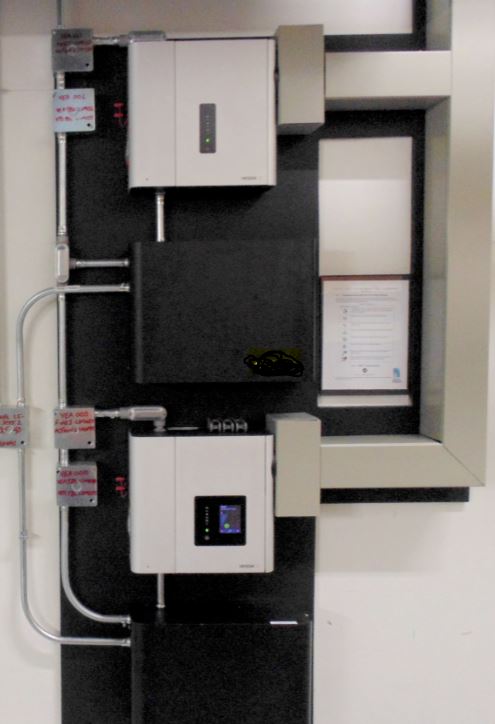Performance-Based Smoke Detection Reduces Cost and Enhances Safety
By Sue Sadler
View full PDF here
Today, the owners of a growing number of non-standard building designs like museums, arenas, stadiums and structures with atria or large open spaces are turning to performance-based design for substantial cost savings and enhanced safety while maintaining architectural concerns. As the International Code Council (ICC) allows “alternate materials and methods” that offer equivalent or superior fire safety performance.

Figure 1: For special architectural features such as atria and large open spaces, advanced smoke detection technology minimizes costs and detects smoke at the earliest possible stage from flexibly placed sampling points
“Performance-based design is really gaining traction for architects with new design and architectural goals, which the prescriptive code cannot handle,” states David Stacy, P.E., Principal and Founder of Performance-Based Fire Protection Engineering, (PBFPE), a firm providing fire protection, life safety, and cost-saving design consultation for U.S. and international structures. “Chief among the challenges of protecting theaters, sports arenas, shopping malls and airport terminals, as well as many structures with entrance lobbies or atria, are massive open spaces where rapid smoke detection has proven to be difficult but is of critical importance.” Such structures are good candidates for performance-based design, using early smoke detection due to the risk of a delayed response that can allow a fire to spread.
For high-risk building conditions, such as large-volume spaces where many occupants may be exposed to the effects of fire, the International Building Code (IBC) calls for smoke control. In case of a fire, such a system will control smoke flow within a building, keep it from spreading to unwanted areas, and provide occupants a clear evacuation route. Typically, for these large-volume spaces, mechanical smoke control or natural venting is used to maintain a smoke-free area as they exit from the building. Building owners and architects often want to limit the complexity and cost of these fans and systems, which can escalate when based on prescriptive approaches.
Consequently, for a growing range of challenging projects, design professionals are turning to performance-based smoke detection to ensure a more efficient design. For open spaces and special architectural features such as atria (large open air or skylight covered space surrounded by a building that are often several stories high), advanced aspirating smoke detector technology that draws in air and tests it at a central unit can detect smoke at the earliest possible stage from flexibly placed, concealable sampling points.
In terms of popular architectural features, Stacy notes that “while atria have become a key aspect of many buildings because they provide a feeling of space and light, achieving sufficient smoke and fire control is vital to modern design approaches.” Atria can be large volume spaces that provide a reservoir for smoke to accumulate. Walkable areas can also be close to the ceiling where the smoke develops quickly, and occupants can be located. “Smoke control systems are required at specific occupancies now to maintain a smoke layer long enough for people to safely egress,” states Stacy.
From small two-story atria to million square foot entertainment and commercial structures, performance-based fire protection engineering, provides design solutions needed to overcome fire protection challenges, increase life safety and obtain cost saving measures. According to Stacy, “on projects ranging from arenas to atria it is usually necessary to determine the requirements and capacities of a smoke control system.”
In smoke detection, such advanced technologies provide early warning by aspirating – or drawing in air – from each room or area through small, flexible tubing. The air is then analyzed to identify the presence of minute smoke particles in a continuous process.
As a multi-channel, addressable system, the central unit can identify the sampling point that is sampling smoke and supports up to 40 sample points. Even in a relatively small open space, you would need an extraordinary amount of exhaust to maintain a smoke layer high enough for people to be safe. Instead, early detection can ensure early detection before untenable conditions occur.

Figure 2: Example of a Multi-channel, Addressable System
Providing early smoke detection with an aspirating system can reduce the required exhaust capacities in open spaces like an atrium. It can also mean fewer mechanical components such as operable doors or louvers that need to open, which simplifies design and cost, he states.
As an example, in a recent project, Stacy says that “the performance-based approach along with aspirating smoke detection improved safety while reducing costs, compared to traditional methods.” When a large art museum on the West Coast required smoke detection throughout the building, the owner also wanted to provide a very quick response to better protect both lives and the exhibits. Stacy notes that “the concern was that the structure contained numerous beam pockets (openings to receive beams in each vertical structural member). Per NFPA 72, a traditional spot-type detector is required within each beam pocket, which would dramatically increase cost and complexity.” As an alternative, Stacy notes that “fire modeling was done to show that if aspirating smoke detection was utilized in every other beam pocket, it could actually perform better than traditional spot type smoke detection within every pocket.” In regard to performance-based design with open spaces and special architectural features, there is ample opportunity to look at streamlined and often superior protection schemes to meet the needs of the client.
Sue Sadler is with Xtralis